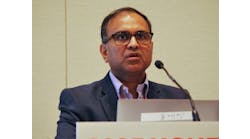The third edition of the Instrumentation Reference Book was published earlier this year by the Butterworths/Heinemann unit of Elsevier Science (Reed Elsevier Group). Butterworths, a venerable London firm, published the proceedings of two key symposia (London 1956 and Amsterdam 1958) that ignited the emerging technology of gas chromatography.
This book is fundamentally a British reference text that derives from the writings of E.B. Jones on instrumentation technology starting in 1953. B.E.N. Dorking edited the first two editions (1988, 1995) but, in a move to open this book to a wider international audience, Elsevier chose Walt Boyes, well-known American instrumentation specialist, to edit this third edition.
It could have been entitled the Measurement Reference Book. It provides thorough coverage of process measurements, chemical composition measurements, electrical and radiation measurements as well as system considerations such as design, installation, commissioning, telemetry, reliability, and safety. Newer developments such as fiberoptic sensor design and MPU-based transmitters are also analyzed.
This volume (1,000-plus pages plus appendices) is divided into five sections:
- Part 1: Mechanical measurements (pressure, level, flow, other)
- Part 2: Temperature and chemical composition measurements
- Part 3: Electrical and radiation measurements
- Part 4: Instrumentation systems
- Part 5: Scientific and technical information
Part 5 is a resource for readers wishing to explore scientific areas or principles underlying instrumentation technology in greater depth. It also includes a chapter on quantities and units.
One of the most puzzling aspects of this book is its attachment to SI units. Ironically, the English have abandoned the English System. After all, English measuring units (BTUs, degrees Fahrenheit, inch-foot-mile, oz-pound-ton) derived from centuries of human effort while the metric system was arbitrarily imposed by Napoleon on the countries that he conquered.
The most frequently run foot race is 27.431999 meters (home plate to first base) and Al Jolson sangs that he "Would walk 1.6093444 million kilometers for one of your smiles..." SI units enable academics, who think in pascals, to keep the working stiffs, who think in psi, at arms length.
Fifty-two people contributed chapters or sections to the Instrumentation Reference Book. All but a few are UK-based. North American authors include: Jonas Berge (MPU-based transmitters), Walt Boyes (flow, density, level), Stanley Dolin (temperature), William Mostia (pneumatics), Jerry Paros (pressure, force), and Ian Verhappen (analyzers).
Chapter 34, titled "History of Instrumentation" and authored by T. Fountain, technical manager for National Instruments UK, is actually a broad ranging discussion of many topics at the interface between instrumentation and real-time computing. Covered are: industrial software, operating systems and graphical programming languages, personal computers for data acquisition and instrument control, industrial networks and protocols, serial data buses, virtual instruments, real-time programming, and virtual instrument software architecture (VISA).
Boyes is strong in the area of mechanical measurements, particularly fluid flow. In association with David Spitzer (www.spitzerandboyes.com), he has produced consumer guides (technical assessments of competitive offerings in specific applications) to a range of flow measurement techniques. These include: Coriolis mass flowmeters, magnetic flowmeters, vortex shedding and fluidic flowmeters, differential pressure flowmeters, and ultrasonic flowmeters.
The chapter on sampling (systems) does not mention the NeSSI concept (New Sample System Initiative) I discussed last month, which is now well into Generation 2. The first reference to include a discussion of NeSSI will scoop the field.
Nevertheless, the Instrumentation Reference Book provides a solid analysis of measurement and instrumentation fundamentals. It also provides basic insights to a number of emerging areas.
Terrence K. McMahon
McMahon Technology Associates
135 Fort Lee Road
Leonia, NJ 07605
Tel: 201-585-2050
Fax: 201-585-1968

Leaders relevant to this article:


